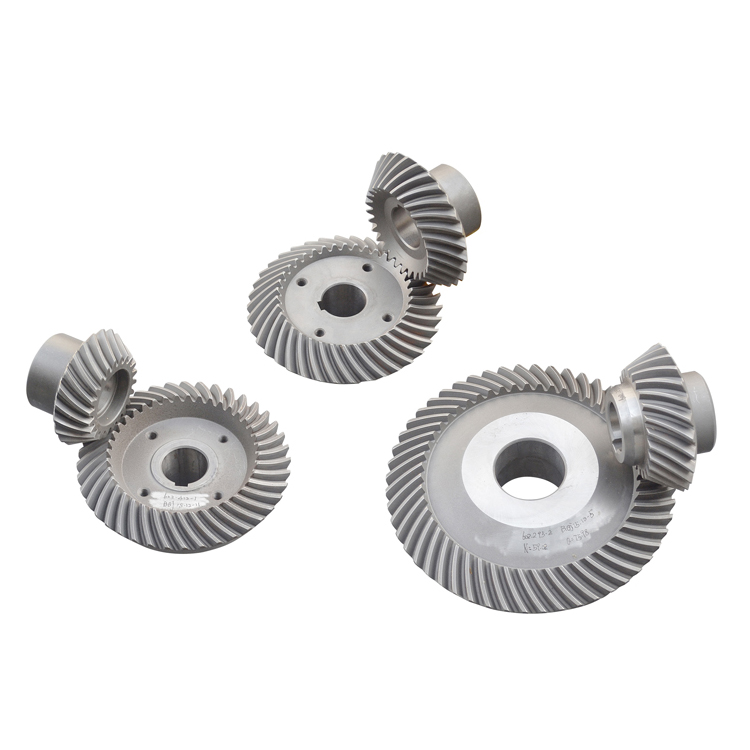Bevel gears are one of the most essential components in mechanical power transmission systems. Their ability to transfer motion and power between shafts that are not parallel makes them invaluable in a range of applications, particularly in industries like automotive, aerospace, and machinery. This article delves into what bevel gears are, their functions, classifications, advantages, and applications.
What Are Bevel Gears?
Bevel gears are gears with teeth that are cut along the conical surface of the gear, usually at an angle to the axis of rotation. Unlike the commonly used spur gears, which have teeth arranged parallel to their axes, bevel gears are designed to mesh with other gears at an angle, typically 90 degrees. This unique design allows bevel gears to transmit rotary motion between shafts that intersect, which is an essential feature in many machines and vehicles.
What is the Function of Bevel Gears?
The primary function of bevel gears is to transfer rotational motion and torque between shafts that are positioned at an angle to each other. This function is critical in mechanical systems where space constraints or design specifications necessitate a change in the direction of power flow. Bevel gears are commonly used in differential drives in vehicles, machinery, and gearboxes, where they facilitate the efficient distribution of power to various components.
For example, in an automotive differential, bevel gears allow the vehicle’s wheels to rotate at different speeds, enabling smooth turns and minimizing tire wear.
How Are Bevel Gears Classified?
Bevel gears are classified based on their tooth design, which determines how the gears mesh and the specific applications they are suited for. The primary types of bevel gears are:
Straight Bevel Gears

These are the most basic type of bevel gears, with straight teeth cut along the cone of the gear. Straight bevel gears are simple and efficient but can generate more noise and are less durable at high speeds. They are typically used in applications with moderate loads and speeds, such as small machinery and power tools.
Spiral Bevel Gears

These gears have curved teeth that offer smoother and quieter operation than straight bevel gears. The teeth of spiral bevel gears are set at an angle to the axis, which results in smoother meshing and reduced stress during operation. Spiral bevel gears are used in high-performance applications where quiet operation, durability, and efficiency are critical, such as in automotive drive systems and industrial machinery.
Hypoid Gears

Hypoid gears are similar to spiral bevel gears but with one key difference—the axes of the gears do not intersect. Hypoid gears are designed to transmit power between shafts that are not only at an angle but also offset. This feature allows for greater load capacity and quieter operation compared to other bevel gears. Hypoid gears are commonly used in the automotive industry, particularly in rear axles and differential systems, where the gear arrangement allows for compact, efficient power transmission.
What Are Bevel Gears Used For?
Bevel gears are integral to a wide range of applications, primarily in systems that require the transfer of motion and power between non-parallel shafts. Here are a few notable uses of bevel gears:
- Automotive Industry: Bevel gears are extensively used in vehicle drive systems, particularly in differential gears, where they help transmit power from the engine to the wheels while allowing them to rotate at different speeds during turns. Hypoid bevel gears are particularly common in automotive differentials because they allow for higher torque transfer in a compact form.
- Machinery and Equipment: In various industrial machinery, bevel gears enable motion transfer in gearboxes, mixers, and conveyor systems where shafts need to be angled. They are also used in elevators, machine tools, and power generation equipment.
- Aerospace: Bevel gears are found in aircraft engines and other systems requiring precise motion transmission in confined spaces.
- Marine and Rail: Ships and trains also utilize bevel gears in propulsion systems where the orientation of the shafts varies.
What Are the Advantages of Bevel Gears?
Bevel gears offer several distinct advantages that make them ideal for use in systems requiring power transmission between intersecting shafts:
- Space Efficiency: Bevel gears are compact and can fit into systems where space is at a premium. Their ability to change the direction of power transmission allows engineers to design more space-efficient systems.
- Power Transmission: Bevel gears are capable of transmitting high torque, which is crucial in applications like automotive differentials and industrial machinery.
- Versatility: With different types available (straight, spiral, and hypoid), bevel gears can be selected to match specific needs for speed, load, and noise level.
- Durability and Strength: When designed and manufactured correctly, bevel gears are durable and can operate reliably over extended periods, even under heavy loads.
- Smooth Operation: Spiral and hypoid bevel gears offer smoother operation, reducing wear and tear and improving overall efficiency.
What is the Difference Between Bevel and Miter Gears?
While bevel gears and miter gears share similar designs, they differ mainly in the gear ratio. Bevel gears can have a variety of gear ratios, depending on the application. In contrast, miter gears are a type of bevel gear specifically designed to have a 1:1 gear ratio, meaning both gears in the pair have the same number of teeth. Miter gears are typically used when the goal is to maintain the same rotational speed between the two shafts while changing the direction of motion.
Comparing Bevel Gears with Other Gear Types
To understand the specific advantages of bevel gears, it’s useful to compare them with other common gear types:
- Spur Gears: Spur gears are the simplest type of gears with straight teeth and are used when the shafts are parallel. They are efficient but generate more noise and are less effective at handling high loads compared to bevel gears.
- Helical Gears: Like bevel gears, helical gears also offer smooth and quiet operation. However, helical gears are typically used when shafts are parallel, unlike bevel gears, which are used when shafts intersect. Helical gears can handle higher loads than spur gears but do not have the same ability to change the direction of power flow as bevel gears.
- Worm Gears: Worm gears are used to transfer motion at a right angle, similar to bevel gears, but they have a unique design where the worm (a screw-like gear) meshes with a worm wheel. Worm gears can achieve high reduction ratios but are less efficient than bevel gears and are often used in applications requiring a compact, non-backdrivable gear arrangement.
Applications and Advantages in the Automotive Industry
In the automotive sector, bevel gears, particularly hypoid bevel gears, are crucial for efficient power transmission in vehicle differentials. They allow the driveshaft’s rotational force to be distributed to the wheels while enabling them to rotate at different speeds when turning. This reduces friction, improves fuel efficiency, and minimizes tire wear. Hypoid bevel gears are preferred for their ability to provide smooth, quiet operation and higher torque handling compared to other types of gears.
Conclusion
Bevel gears are indispensable in many industries due to their ability to transfer power between shafts that are not parallel. Whether straight, spiral, or hypoid, these gears offer unique benefits depending on the specific application, from automotive differentials to industrial machinery. Their ability to provide efficient, durable, and smooth power transmission in confined spaces makes them an ideal choice for a variety of engineering challenges.
By recognizing the strengths and appropriate applications of bevel gears, you can better navigate the design, selection, and sourcing processes, ensuring optimal performance and reliability in your mechanical systems.
Thank you for reading. We are looking forward to serving you with our exceptional gear solutions. #BeyondGears
Read More:


